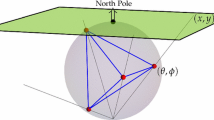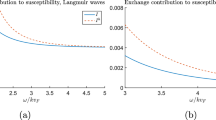Abstract
The two-dimensional one-component plasma—2dOCP—is a system composed by \(n\) mobile particles with charge \(q\) over a neutralizing background in a two-dimensional surface. The Boltzmann factor of this system, at temperature \(T\), takes the form of a Vandermonde determinant to the power \(\Gamma = q^2/(2\pi \varepsilon k_BT)\), where \(\Gamma \) is the coupling constant of this Coulomb system. The partition function of the model has been computed exactly for the even values of the coupling constant \(\Gamma \), and a finite number of particles \(n\), by two means: (1) by recognizing that the Boltzmann factor is the square of a Jack polynomial and expanding it in an appropriate monomial base, and (2) by mapping the system onto a 1-dimensional chain of interacting fermions. In this work the connection among the two methods is derived, and some properties of the expansion coefficients for the power of the Vandermonde determinant are explored.
Similar content being viewed by others
Notes
Effectively, since the multiplication runs from 1 to \(n\) on non-repeated indexes, there are \(n(n-1)/2\) terms in it. Because each term is elevated to the power \(2p\), the total order of each term in the expansion is \(2p\) times \(n(n-1)/2\), which is \(n(n-1)p\).
If, for example, we are dealing with two particles and \(\Gamma = 4\), \(n(n-1)p=4\), and a possible partition may be \(\mu =(2,2)\). The monomial would be then:
$$\begin{aligned} \sum _{\sigma \in S_2} z_1^{\sigma (\mu _1)} z_2^{\sigma (\mu _2)}=z_1^2z_2^2+z_2^2z_1^2=2z_1^2z_2^2. \end{aligned}$$The term with the product appears in (29) to compensate the factor of \(2\) (which is precisely the frequency, \(\lambda _2=2\), of apparition of the number \(2\) in the partition \((2,2)\)).
This would not be true if not were for the fact that \(\mu \) and \(\nu \) are ordered partitions.
This is, in the case of \(\gamma \) even bigger than 2. If \(\gamma \) is odd, the things are much easier, since the term \(c_{i_1,\ldots ,i_{n-2},K/2,K/2}\) does not even appear.
These two compositions belong to the limiting cases \(K=\gamma \) and \(K=\gamma (2n-3)\).
References
Jancovici, B.: Exact results for the two-dimensional one-component plasma. Phys. Rev. Lett. 46(6), 386–388 (1981)
Alastuey, A., Jancovici, B.: On the classical two-dimensional one-component coulomb plasma. J. Phys. 42(1), 1–12 (1981)
Caillol, J.M.. Exact results for a two-dimensional one-component plasma on a sphere. J. Phys. Lett. 42(12) (1981)
Šamaj, L., Percus, J.K.: A functional relation among the pair correlations of the two-dimensional one-component plasma. J. Stat. Phys. 80(3/4), 811–824 (1995)
Forrester, P.J.. Log-Gases and Random Matrices. Princeton University Press (2010)
Téllez, G., Forrester, P.J.: Expanded Vandermonde powers and sum rules for the two-dimensional one-component plasma. J. Stat. Phys. 147(4), 825–855 (2012)
Téllez, G., Forrester, P.J.: Exact finite-size study of the 2d-OCP at \(\Gamma = 4\) and \(\Gamma = 6\). J. Stat. Phys. 97(3/4), 489–521 (1999)
Ginibre, J.: Statistical ensembles of complex, quaternion, and real matrices. J. Math. Phys. 6(3), 440–449 (1965)
Šamaj, L.: Is the two-dimensional one-component plasma exactly solvable? J. Stat. Phys. 117(1/2), 131–158 (2004)
Regnault, N., Bernevig, B.A.: Anatomy of abelian and non-abelian fractional quantum Hall states. Phys. Rev. Lett. 103(20), 206801 (2009)
Regnault, N., Thomale, R., Estienne, B., Bernevig, B.A.: Decomposition of fractional quantum Hall model states: product rule symmetries and approximations. Phys. Rev. B 84(4):045127 (2011)
Macdonald, I.G.: Hall Polynomials and Symmetric Functions. Oxford University Press (1995)
Acknowledgments
G.T. acknowledges partial financial support from ECOS Nord/COLCIENCIAS-MEN-ICETEX.
Author information
Authors and Affiliations
Corresponding author
Rights and permissions
About this article
Cite this article
Grimaldo, J.A.M., Téllez, G. Relations Among Two Methods for Computing the Partition Function of the Two-Dimensional One-Component Plasma. J Stat Phys 160, 4–28 (2015). https://doi.org/10.1007/s10955-015-1249-2
Received:
Accepted:
Published:
Issue Date:
DOI: https://doi.org/10.1007/s10955-015-1249-2




